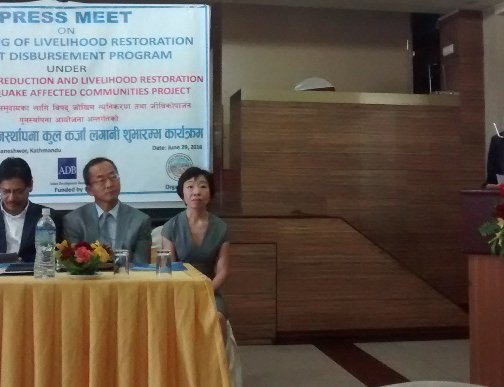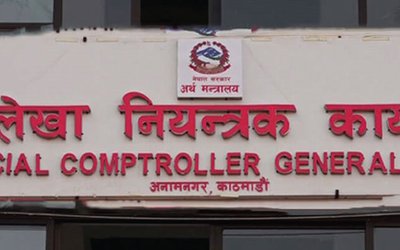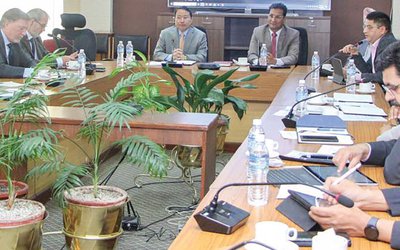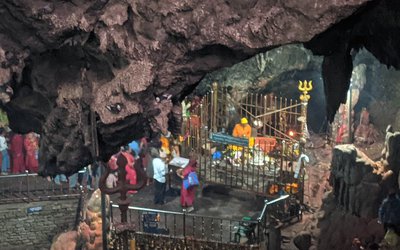
Apsara Adhikary, chair of Kebalpur Sana Kisan Krishi Sahakari Sangh (Kebalpur Small Farmers Agriculture Cooperatives), was upbeat on receiving a check of over 20 million rupees.
“This is a moment of joy for me as I received a check of 22 million rupees to distribute to over 400 small farmers who have lost their houses. This amount will revive the hope of the small farmers, who are living in temporary shelters, after losing all the means of livelihood,” said Adhikary.
Sanu Bhai Khanal, president of Chhatre Deurali Village Cooperatives, Dhading, too has a similar response. "Despite certain amount of money to distribute as loan, it will cover only half of victims. This money will revive the livelihood of people who are still living in the temporary shelters,” said Khanal. “As there is still uncertainty over the distribution of subsidy money by National Reconstruction Authority, this money will give relief to the needy victims.”
Like in Kebalpur and Chhatre Deurali, there are 756 Small Farmers Agriculture Cooperatives (SFACLs) taking micro-finance activities throughout the country, providing loan to the poor farmers.
“Among the earthquake affected people, over 12500 severely affected smallholder poor households will be provided credit not exceeding Rs.50,000.00 at the interest rate of 5 percent,” said Jalan Kumar Sharma, chief Executive officer of SKBBL. “Out of 300 million rupees allocated to distribute in this fiscal year, we distributed 190 million and remaining will be distributed through other SAFCLs.”
With the disbursement of 190 million rupees to 20 SFACLs on Friday, Livelihood Restoration Credit for Earthquake Affected Communities program was formally launched.
Joint Secretary of Ministry of Finance Surya Prasad Acharya, Asian Development Bank’s country Director Kenichi Yokoyama and Chairman of Small Farmer Development Bank Khem Bahadur Pathak jointly launched the program distributing soft loan to the chairman of the SFACLs.
With nationwide networking at the grass root levels, SKBBL has a direct reach at the grassroots level people through its member cooperatives. Out of many micro-credit agencies, SKBBL interest rate is just an average 5 percent.
“This will provide a relief to the families of small farmers just on the onset of monsoon,” said Mayumi Ozaki, Financial Sector Specialist (Rural and Microfinance), South Asia Department.
Having over three decades long experiences working to improve the small farmers through Agriculture Development Bank, Jalan Kumar Sharma, Chief Executive Officer of SKBBL, knows effective ways to reach the needy people.
Along with the efficient management at center, SKKBL has shown through its program how quickly the money can reach at the hands of poor and needy people.
Although almost 15 months have already passed, many people are still struggling to get the necessary support to rebuild the houses and revive livelihood. Out of over 8 million affected families, overwhelming families of small farmers are still living in shelters made from tarpaulins and corrugated iron sheets, which provide little protection from the harsh monsoon rains in Nepal.
As there was a delay in establishing the National Reconstruction Authority, the operation of distribution of the loan has started just this year.
“ADB’s Disaster Risk Reduction and Livelihood Restoration Project will help counter that in cooperation with the Small Farmers’ Development Bank, which will channel microcredit through its network of small farmers’ cooperatives and through them to borrowers. The bank has 85 cooperatives in affected districts, and will show that well-organized microfinance institutions have a key role to play in providing relief and post-disaster support quickly. Microfinance can also reduce the cost of disaster recovery financing, while reducing aid dependency and building long-term resilience to disasters,” said Keinichi Yokoyama.
Out of Nepal's total population of 27 million, 13 million have no access to formal financial services. Even before the earthquake, microfinance institutions were heavily concentrated in the most accessible cities and towns, and only reached about 23% of the 14 million Nepalis who could access finance. Microfinance institutions with networks in rural areas also had difficulties because their resources were too limited to meet with the sudden surge in demand from affected people.
With all advantages, Ministry of Finance and Asian Development Bank chose SKKBL to issue loan to the earthquake victims under the credit for livelihood Restoration.
Ministry of Finance has provided the fund to SKBBL under ‘Disaster Risk Reduction and Livelihood Restoration Project’, which was approved by ADB in October 2015.
With $15 million grant funding by the Japanese government, the project aims to accelerate reconstruction and livelihood restoration of the earthquake affected areas, with a focus on small and marginal farmers and landless households that were most heavily affected by the disaster.
As National Reconstruction Authority is struggling to distribute state subsidy Rs.50, 000.00 each credit with five percent annual interest to more than one thousand victims under a Livelihood Restoration Credit Disbursement Program within a matter of day.
“The loans of up to NR50,000 (about $460) to help families restore their houses, farmland, livestock, or micro enterprises are part of ADB’s $15 million Disaster Risk Reduction and Livelihood Restoration Project funded by the Government of Japan. The three-part project aims to provide concessional microcredit to at least 12,500 households affected by the tremors, and targets particularly poor and vulnerable households that have no alternative sources of financial assistance. It will also rebuild or retrofit model schools and provide training on disaster risk management,” said Kenichi Yokoyama ADB Country Director for Nepal.
“Under the program, the Ministry of Finance has extended Rs 640 million to SKBBL to finance income-generating activities of the earthquake-affected districts and conduct reconstruction-related training," said joint secretary Acharya.
According to SKBBL, Rs 550 million will be mobilized through cooperatives to issue concessional loans to the affected household three districts. And Rs 90 million will be mobilized to conduct training programs of carpentry, masons, among others to prepare human resources to support the reconstruction drive. Training activities will be conducted in worst-hit nine districts, apart from the three in the Valley.
The fund that SKBBL received from the government at zero interest rate has a payback period of five years. Similarly, the SKBBL has fixed payback period of three years when extending such loans. The Ministry of Finance released the fund to SKBBL last week.
Nepal government’s Post Disaster Needs Assessment, published shortly after the earthquakes, said that the disaster disproportionately affected the poor, who have few emergency funds to fall back, especially those in rural locations where houses were less robust and poverty tends to be higher.
“It also estimated that as a result of the catastrophe an additional 2.5%-3.5% of the population will be pushed into poverty during the 2015-2016 fiscal years, which translated into at least 700,000 additional poor. Roughly 50%-70% of the will be from the rural central hill and mountain region, where vulnerability prior to the earthquake was already high,” said Kenichi Yokoyama ADB Country Director for Nepal.
The central Dhading District, which was one of the districts most severely affected by the earthquake, even before the disaster, was one of the poorest districts in Nepal with a Human Development Index (HDI) ranking of 0.461 versus the country average of 0.491.
With the loan in hand, the families in Dhading, Rasuwa and Nuwakot, can now, finally, start rebuilding their lives.
- TANAHU HYDROPOWER PROEJCT: A Significant Achievement
- Apr 15, 2024
- AMBASSADOR HANAN GODAR: Sharing Pain With A Nepali Family
- Mar 30, 2024
- VISIT OF KfW AND EIB TO NEPAL : Mission Matters
- Mar 25, 2024
- NEPAL BRITAIN SOCIETY: Pratima Pande's Leadership
- Mar 24, 2024
- NEPAL ARMY DAY: Time To Recall Glory
- Mar 15, 2024
















